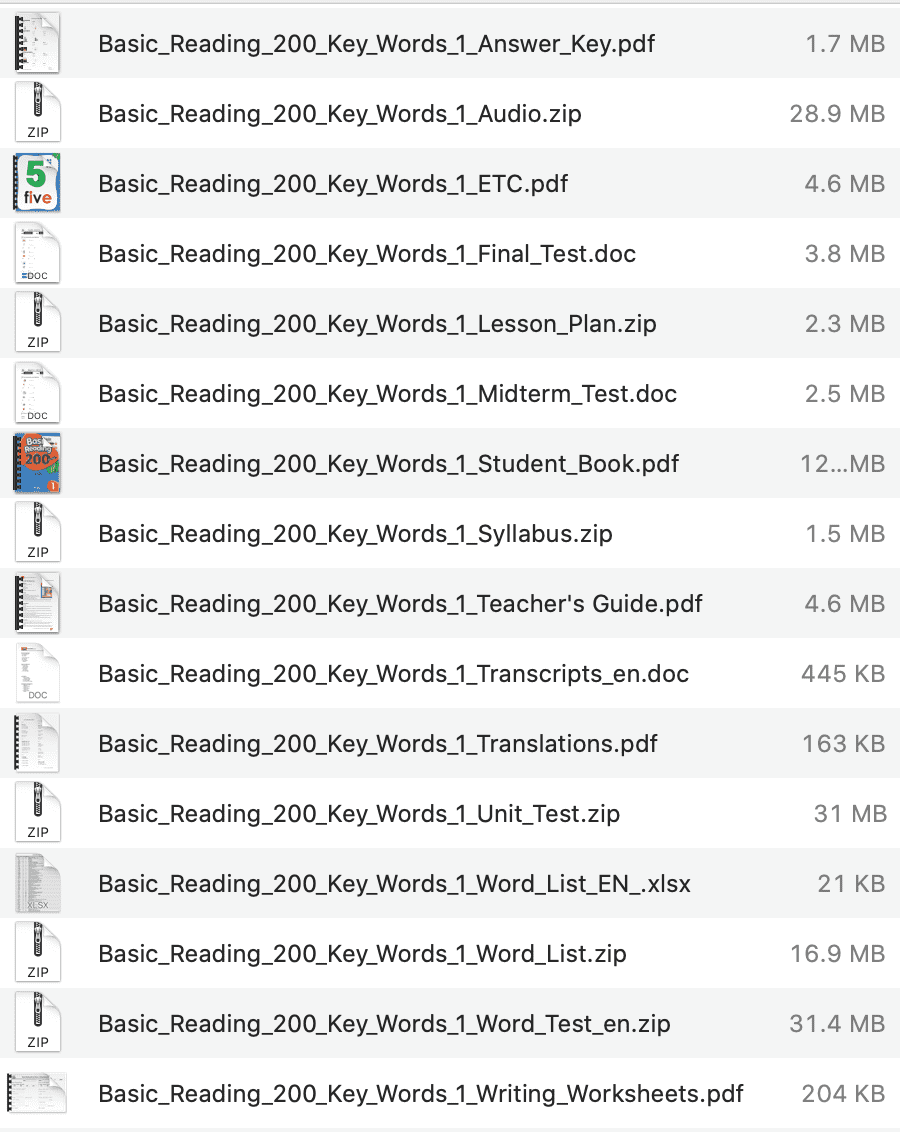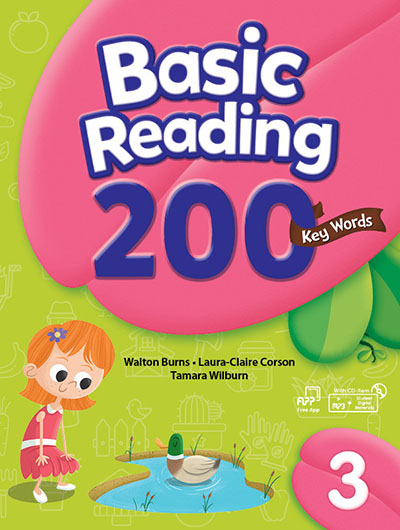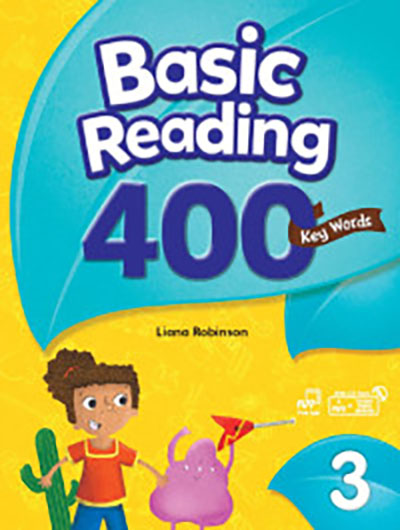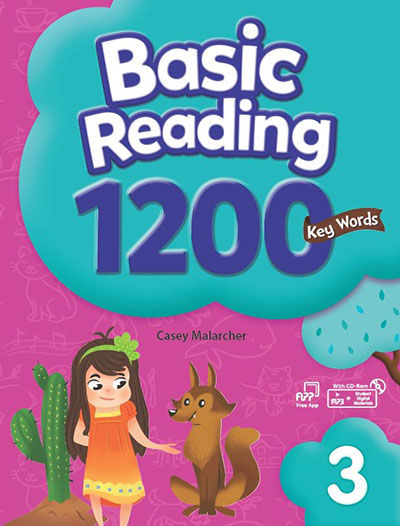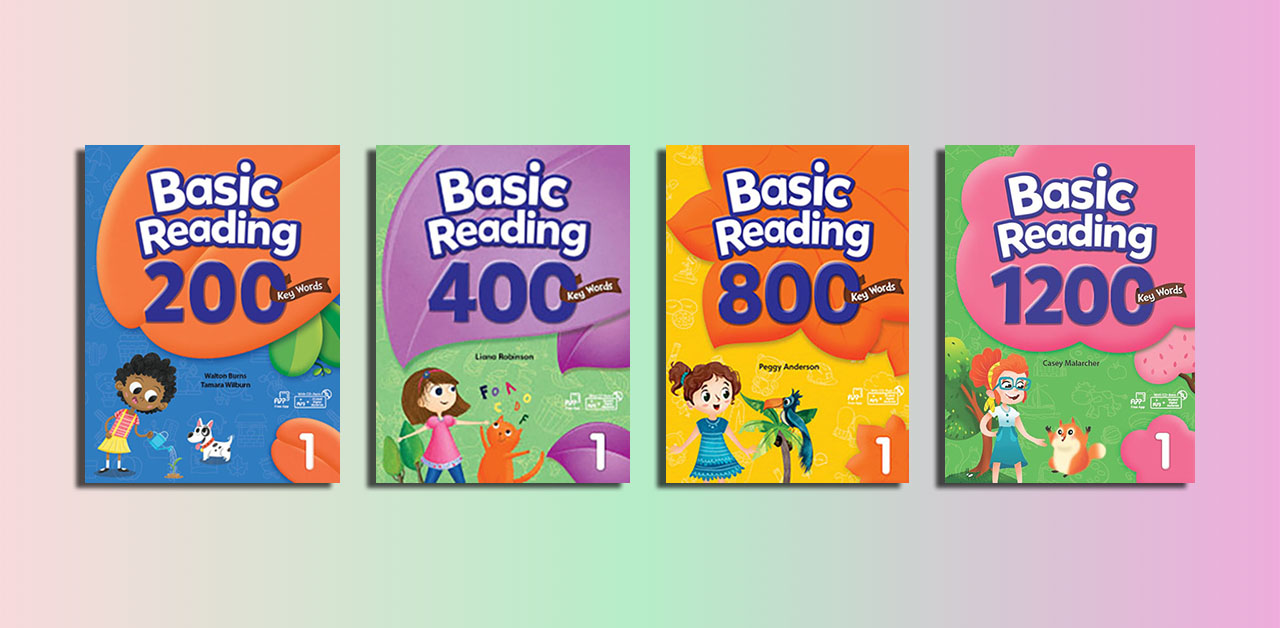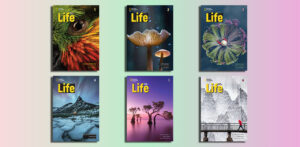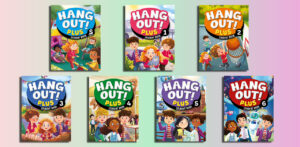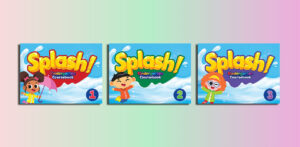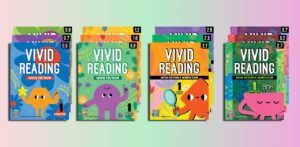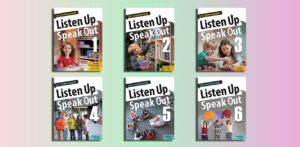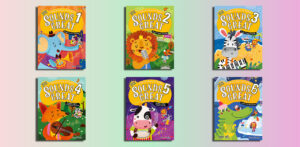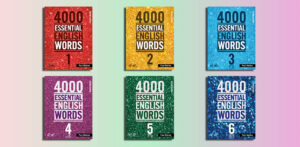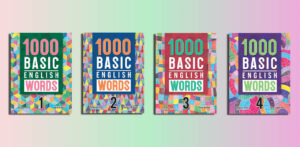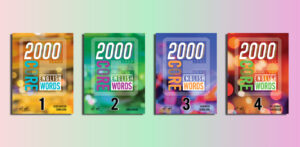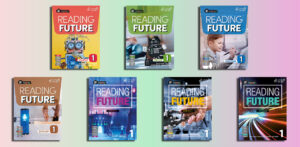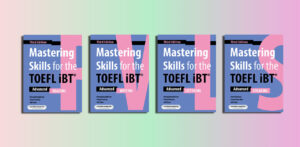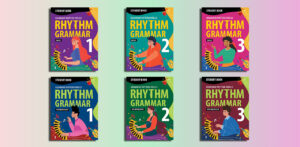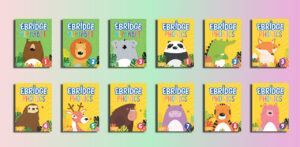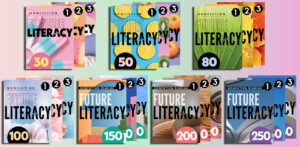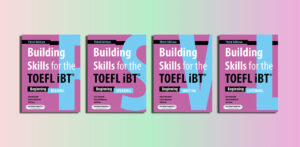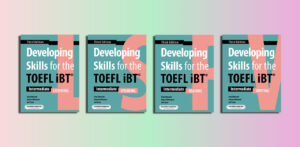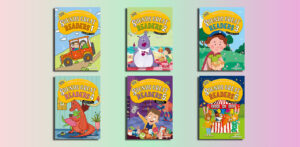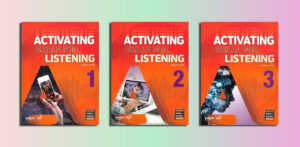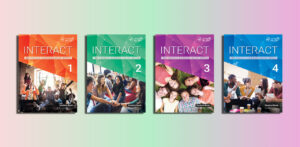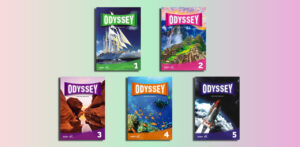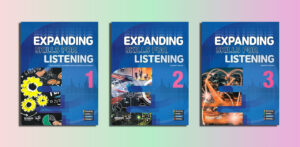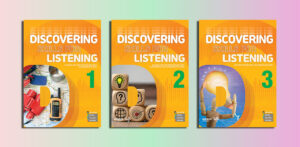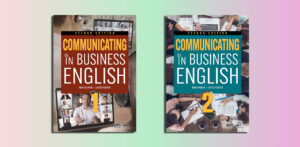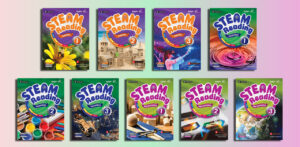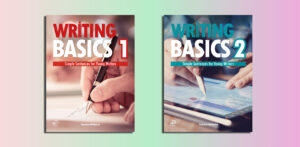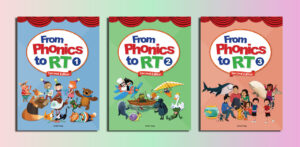Compass, Download, Online iTools
Download Compass Basic Reading Pdf Resources (Pre A1 / A2)
Basic Reading (PDFs, Resources)
Basic Reading 200 Key Words (Pre A1) Set
Level 1 (Pre A1)
Basic Reading 200 Key Words 1 Student Book.pdf – Sample: Click
Answer Key – Audio – ETC – Final Test – Lesson Plan – Midterm Test – Student Book – Syllabus – Teacher’s Guide – Transcripts – Translations – Unit Test – Word List – Word Test – Writing Worksheets
Level 2 (Pre A1)
Basic Reading 200 Key Words 2 Student Book.pdf – Sample: Click
Answer Key – Audio – ETC – Final Test – Lesson Plan – Midterm Test – Student Book – Syllabus – Teacher’s Guide – Transcripts – Translations – Unit Test – Word List – Word Test – Writing Worksheets
Level 3 (Pre A1)
Basic Reading 200 Key Words 3 Student Book.pdf – Sample: Click
Answer Key – Audio – ETC – Final Test – Lesson Plan – Midterm Test – Student Book – Syllabus – Teacher’s Guide – Transcripts – Translations – Unit Test – Word List – Word Test – Writing Worksheets
Basic Reading 400 Key Words (Pre A1) Set
Level 1 (Pre A1)
Basic Reading 400 Key Words 1 Student Book.pdf – Sample: Click
Answer Key – Audio – ETC – Final Test – Lesson Plan – Midterm Test – Student Book – Syllabus – Teacher’s Guide – Transcripts – Translations – Unit Test – Word List – Word Test – Writing Worksheets
Level 2 (Pre A1)
Basic Reading 400 Key Words 2 Student Book.pdf – Sample: Click
Answer Key – Audio – ETC – Final Test – Lesson Plan – Midterm Test – Student Book – Syllabus – Teacher’s Guide – Transcripts – Translations – Unit Test – Word List – Word Test – Writing Worksheets
Level 3 (Pre A1)
Basic Reading 400 Key Words 3 Student Book.pdf – Sample: Click
Answer Key – Audio – ETC – Final Test – Lesson Plan – Midterm Test – Student Book – Syllabus – Teacher’s Guide – Transcripts – Translations – Unit Test – Word List – Word Test – Writing Worksheets
Basic Reading 800 Key Words (A1 / A1+) Set
Level 1 (A1)
Basic Reading 800 Key Words 1 Student Book.pdf – Sample: Click
Answer Key – Audio – ETC – Final Test – Lesson Plan – Midterm Test – Student Book – Syllabus – Teacher’s Guide – Transcripts – Translations – Unit Test – Word List – Word Test – Writing Worksheets
Level 2 (A1)
Basic Reading 800 Key Words 2 Student Book.pdf – Sample: Click
Answer Key – Audio – ETC – Final Test – Lesson Plan – Midterm Test – Student Book – Syllabus – Teacher’s Guide – Transcripts – Translations – Unit Test – Word List – Word Test – Writing Worksheets
Level 3 (A1 / A1+)
Basic Reading 800 Key Words 3 Student Book.pdf – Sample: Click
Answer Key – Audio – ETC – Final Test – Lesson Plan – Midterm Test – Student Book – Syllabus – Teacher’s Guide – Transcripts – Translations – Unit Test – Word List – Word Test – Writing Worksheets
Basic Reading 1200 Key Words (A1+ / A2) Set
Level 1 (A1+)
Basic Reading 1200 Key Words 1 Student Book.pdf – Sample: Click
Answer Key – Audio – ETC – Final Test – Lesson Plan – Midterm Test – Student Book – Syllabus – Teacher’s Guide – Transcripts – Translations – Unit Test – Word List – Word Test – Writing Worksheets
Level 2 (A1+)
Basic Reading 1200 Key Words 2 Student Book.pdf – Sample: Click
Answer Key – Audio – ETC – Final Test – Lesson Plan – Midterm Test – Student Book – Syllabus – Teacher’s Guide – Transcripts – Translations – Unit Test – Word List – Word Test – Writing Worksheets
Level 3 (A1+ / A2)
Basic Reading 1200 Key Words 3 Student Book.pdf – Sample: Click
Answer Key – Audio – ETC – Final Test – Lesson Plan – Midterm Test – Student Book – Syllabus – Teacher’s Guide – Transcripts – Translations – Unit Test – Word List – Word Test – Writing Worksheets
Overview of “Basic Reading” by Compass Publishing
Contents
| ✅ Coursebook: | Basic Reading |
| ✅ Author: | Walton Burns, Tamara Wilburn, Anne Hendler, Jenna Myers, Laura-Claire Corson, Liana Robinson, Peggy Anderson, Nick Scherf, August Niederhaus, Casey Malarcher |
| ✅ Publisher: | Compass Publishing |
| ✅ Levels: | Pre A1, A1, A1+, A2 |
| ✅ English type: | International English |
| ✅ Skill: | Reading, Vocabulary |
| ✅ For: | Primary |
| ✅ Publication year: | 2017 |
The “Basic Reading” series is a twelve-level program crafted to guide young students of English from the learning-to-read stage to the reading-to-learn stage. Published by Compass Publishing, this series systematically reinforces high-frequency vocabulary and sentence structures while introducing a controlled number of new vocabulary items per unit. This structured approach allows learners to build fluency and comprehension comfortably, broadening their understanding of various English word forms and sentence patterns. The captivating stories, supported by detailed illustrations, aid in reading comprehension and prepare students for the demands of academic material at higher levels.
Target Audience and Progression
- The series caters to a range of learners, starting with basic beginners (Pre A1) and progressing to intermediate learners (A1+/A2), aligned with the Common European Framework of Reference for Languages (CEFR).
- It is divided into four main levels:
- Basic 200: For beginning readers (Pre A1).
- Basic 400: For basic to beginner learners (Pre A1).
- Basic 800: For beginner to high beginner learners (A1 to A1+).
- Basic 1200: For high beginner to intermediate learners (A1+ to A2).
- Each level builds on the previous one, introducing progressively complex content while maintaining a supportive learning environment.
Key Features
The series is enriched with a variety of tools and activities to enhance the learning experience:
- Graded Reading Passages: Cover a broad range of topics, tailored to the learners’ proficiency levels, ensuring engagement and relevance.
- Color Illustrations: Enhance comprehension by providing visual context to the text.
- Consistent Sentence Structures: Repeated use of prevalent structures supports fluency development through familiarity.
- Four-Strand Approach: Exercises and activities focus on meaning-focused input, meaning-focused output, language-focused learning, and fluency development, offering a balanced learning method.
- Repetition of High-Frequency Vocabulary: Reinforces essential words to build a strong lexical foundation.
- Review Units: Each book includes two review units, with the first three books in each level featuring original songs to reinforce learning through music.
- Multimedia Support: MP3 CDs, including a “Class Booster,” provide auditory learning opportunities.
Content Structure
- Each level (200, 400, 800, 1200) consists of three “Key Words” books, written by different authors to bring diverse teaching perspectives:
- Basic 200: Authored by Walton Burns, Tamara Wilburn, Anne Hendler, Jenna Myers, and Laura-Claire Corson.
- Basic 400: Authored by Liana Robinson across all three books.
- Basic 800: Authored by Peggy Anderson, Anne Hendler, Nick Scherf, Jenna Myers, and August Niederhaus.
- Basic 1200: Authored by Casey Malarcher across all three books.
- The books focus on specific skills at each level:
- Basic 200: Very simple passages for foundational reading.
- Basic 400: Repetition of high-frequency vocabulary through engaging passages.
- Basic 800: Consolidation of grammar and word usage understanding.
- Basic 1200: Comprehension activities in textual and graphic formats.
Educational Goals
The “Basic Reading” series aims to:
- Develop reading fluency through structured repetition and graded content.
- Enhance comprehension with visual and auditory aids.
- Prepare learners for academic reading by introducing a variety of topics and sentence structures.
- Provide a scaffolded progression that aligns with CEFR standards, ensuring learners can advance confidently.
Unique Aspects
- The inclusion of original songs in the review units of the first three books adds an interactive and enjoyable element, particularly beneficial for younger learners.
- The pull-out workbooks and MP3 CDs offer flexible, supplementary resources for both classroom and self-study environments.
- The consistent use of a four-strand approach ensures a holistic development of language skills, catering to different learning styles.
Conclusion
The “Basic Reading” series by Compass Publishing is a thoughtfully designed, multi-level program that supports English language learners at various stages of proficiency. With its engaging content, multimedia resources, and structured progression, it serves as an effective tool for educators and students alike, fostering a strong foundation in reading and preparing learners for more advanced academic challenges.
Basic Reading 200 Key Words 3 Student Book
Who is suitable for “Basic Reading”?
The “Basic Reading” series by Compass Publishing is designed to cater to a wide range of young English language learners, making it suitable for specific groups based on their proficiency levels and learning needs. Below is an overview of who is suitable for this series, based on the provided information:
Suitable Audience for “Basic Reading”
Young Learners Transitioning from Learning-to-Read to Reading-to-Learn
- The series targets young students who are moving from the initial stage of learning to decode and recognize words (learning-to-read) to the stage where they can use reading to acquire new knowledge and skills (reading-to-learn). This makes it ideal for children or beginner adult learners who are building foundational literacy skills.
Beginner to Intermediate English Learners
- The twelve-level program spans a range of proficiency levels, aligned with the Common European Framework of Reference for Languages (CEFR):
- Pre A1: Suitable for absolute beginners with little to no prior English knowledge (Basic 200 and 400).
- A1 to A1+: Appropriate for beginner to high beginner learners who can handle basic communication and understand simple texts (Basic 800).
- A1+ to A2: Ideal for high beginner to intermediate learners who are ready for more complex comprehension tasks (Basic 1200).
- This progression ensures that learners at different stages of English acquisition can find a level that matches their current abilities.
Students Seeking Structured Vocabulary and Grammar Development
- The series systematically reinforces high-frequency vocabulary and sentence structures while introducing a controlled number of new vocabulary items per unit. It is suitable for learners who benefit from a structured approach to building fluency and understanding English word forms and sentence patterns.
Learners Aided by Visual and Auditory Support
- With features like color illustrations, original songs in review units, and MP3 CDs (including a “Class Booster”), the series is well-suited for visual and auditory learners. Young children, in particular, who thrive with engaging, multimedia resources, will find this approach beneficial.
Classroom and Self-Study Learners
- The inclusion of pull-out color workbooks and review units makes the series adaptable for both classroom settings (with teacher guidance) and independent study. It is suitable for students in formal education environments as well as those learning English in informal or self-directed contexts.
Students Preparing for Academic Reading
- The series prepares learners for the demands of academic material at higher levels by using graded reading passages on a broad range of topics and detailed illustrations to aid comprehension. It is ideal for students who aim to transition to more advanced reading tasks in school or academic settings.
Specific Suitability by Level
- Basic 200 (Pre A1): Best for very young learners or complete beginners who need very simple passages and foundational support to start reading in English.
- Basic 400 (Pre A1): Suitable for basic to beginner learners who are ready to reinforce high-frequency vocabulary through interesting, slightly more complex passages.
- Basic 800 (A1 to A1+): Appropriate for beginner to high beginner learners who need to consolidate their understanding of grammar and word usage.
- Basic 1200 (A1+ to A2): Ideal for high beginner to intermediate learners who can handle comprehension activities in both textual and graphic formats and are preparing for more advanced reading.
Who Might Not Be Suitable?
- Advanced Learners (B1 and Above): Learners at intermediate to advanced levels (e.g., B1, B2) may find the content too basic, as the series tops out at A2 and focuses on foundational to intermediate skills.
- Non-Visual or Auditory Learners: While the series includes multimedia, learners who prefer text-only materials might find the emphasis on illustrations and songs less appealing.
- Older Learners with Specific Goals: Adults learning English for professional or highly specialized purposes (e.g., technical or business English) might need more targeted materials beyond the general reading focus of this series.
Conclusion
The “Basic Reading” series is most suitable for young English learners, ranging from absolute beginners (Pre A1) to intermediate learners (A2), who benefit from a structured, engaging, and multimedia-supported approach to reading development. It is particularly effective for students in early education or language programs who are building foundational skills and preparing for academic challenges.
Basic Reading 400 Key Words 3 Student Book
The benefits of “Basic Reading”
Structured Progression for Skill Development
- The twelve-level series provides a clear, step-by-step path from the learning-to-read stage (decoding words) to the reading-to-learn stage (using reading for knowledge acquisition). This scaffolded approach ensures learners build skills incrementally, moving from Pre A1 to A2 CEFR levels.
- Each level (200, 400, 800, 1200) targets specific competencies—starting with simple passages, advancing to vocabulary reinforcement, grammar consolidation, and finally comprehension skills—allowing learners to grow confidently at their own pace.
Enhanced Vocabulary and Fluency
- The systematic reinforcement of high-frequency vocabulary and sentence structures, with a controlled introduction of new words per unit, helps learners expand their lexical knowledge and improve fluency.
- Repetition of key vocabulary and consistent use of prevalent sentence patterns enable learners to recognize and use English more naturally, a critical foundation for effective communication.
Improved Comprehension Through Engaging Content
- Graded reading passages cover a broad range of topics, keeping learners engaged while exposing them to diverse contexts. This variety broadens their understanding and prepares them for real-world reading tasks.
- Color illustrations aid in comprehension by providing visual cues, making it easier for learners—especially young children or visual learners—to grasp the meaning of texts.
Holistic Language Learning with the Four-Strand Approach
- The series employs a four-strand approach (meaning-focused input, meaning-focused output, language-focused learning, and fluency development), ensuring a balanced development of reading skills. This method caters to different learning styles, reinforcing understanding through reading, practice, study, and fluency exercises.
- Activities and exercises are designed to build fluency in English, helping learners transition from basic recognition to confident application.
Multimedia and Interactive Learning Opportunities
- Original songs in the review units of the first three books add an auditory and interactive element, making learning enjoyable and memorable, particularly for young learners.
- MP3 CDs, including a “Class Booster,” provide auditory support, allowing learners to hear proper pronunciation and intonation, which enhances listening skills alongside reading.
- The pull-out color workbook offers hands-on practice, reinforcing concepts through written exercises and encouraging independent learning.
Basic Reading 800 Key Words 3 Student Book
Preparation for Academic Success
- The series features detailed illustrations and captivating stories that prepare learners for the demands of academic reading at higher levels. By exposing students to varied sentence structures and topics, it builds the skills needed for more complex texts in educational settings.
- The progression to comprehension activities in both textual and graphic formats (especially in Basic 1200) equips learners with the ability to analyze and interpret information, a key academic skill.
Flexibility for Diverse Learning Environments
- Suitable for both classroom and self-study settings, the series’ inclusion of workbooks and MP3s allows teachers to integrate it into lessons or learners to use it independently.
- The two review units per book, with reinforcement through songs and activities, provide opportunities for assessment and consolidation, benefiting both educators and students.
Support for Young and Beginner Learners
- Tailored for young students, the engaging design (e.g., colorful illustrations, songs) makes learning appealing and less intimidating, fostering a positive attitude toward reading.
- The focus on foundational skills is ideal for absolute beginners (Pre A1) who need a gentle introduction to English, as well as those progressing to intermediate levels (A2).
Alignment with Global Standards
- The series’ alignment with CEFR levels (Pre A1 to A2) ensures it meets internationally recognized benchmarks for language proficiency, making it a reliable tool for learners and educators worldwide as of March 18, 2025.
- This alignment also supports standardized assessments and curriculum planning for schools or language programs.
Encouragement of Long-Term Language Growth
- By building a strong foundation in reading, vocabulary, and grammar, the series sets learners up for long-term success in English language acquisition, potentially easing their transition to more advanced courses or real-life language use.
Conclusion
The “Basic Reading” series offers a robust, engaging, and well-rounded approach to English reading development. Its benefits—ranging from structured skill progression and enhanced comprehension to multimedia support and academic preparation—make it an invaluable resource for young learners, particularly those at beginner to intermediate levels. The combination of visual, auditory, and written elements, along with a focus on fluency and comprehension, ensures that learners not only improve their reading skills but also develop a lasting appreciation for the language.
Basic Reading 1200 Key Words 3 Student Book
Effective learning strategies for “Basic Reading”
To maximize the benefits of the “Basic Reading” series by Compass Publishing, learners and educators can adopt a variety of effective learning strategies tailored to its structured design, multimedia resources, and four-strand approach. Below are practical strategies that can enhance the learning experience for students at all levels (200, 400, 800, 1200), based on the series’ features and target audience.
1. Leverage the Four-Strand Approach
- Meaning-Focused Input: Encourage learners to read the graded passages aloud or silently, focusing on understanding the story or topic with the help of color illustrations. Discuss the main ideas to reinforce comprehension.
- Meaning-Focused Output: Have students retell stories or passages in their own words, either verbally or through the workbook exercises, to practice applying what they’ve learned.
- Language-Focused Learning: Use the consistent sentence structures and high-frequency vocabulary as a basis for targeted lessons. For example, create activities where students identify and categorize new words or practice sentence patterns.
- Fluency Development: Encourage repeated reading of passages or songs from the MP3 CDs to build speed and confidence. Timed reading exercises can also help track progress.
2. Utilize Multimedia Resources
- Engage with MP3 CDs and Songs: Listen to the original songs in the review units (especially in the first three books of each level) to improve pronunciation, intonation, and listening skills. Sing along to reinforce memory and make learning fun.
- Class Booster Integration: Use the “Class Booster” audio to supplement lessons, encouraging group listening activities or pair work where students repeat phrases together.
- Visual Learning: Regularly refer to the color illustrations during reading sessions to connect visuals with text, helping learners visualize meaning and improve recall.
3. Maximize Workbook Activities
- Structured Practice: Complete the pull-out color workbook exercises after reading passages to reinforce vocabulary, grammar, and comprehension. Use these as homework or in-class assignments to solidify learning.
- Creative Extension: Encourage students to create their own simple stories or drawings based on workbook prompts, promoting active engagement and creativity.
- Review and Reflect: Use the workbook as a tool for self-assessment, having learners check their answers and revisit difficult sections with a teacher or peer.
4. Incorporate Repetition and Review
- Revisit Key Vocabulary: Regularly review high-frequency words using flashcards, word games, or the repetition exercises in the books to build a strong lexical foundation.
- Utilize Review Units: Dedicate time to the two review units per book, focusing on the songs and activities to consolidate learning. Turn reviews into interactive sessions with group singing or quizzes.
- Spaced Repetition: Schedule periodic reviews of earlier levels (e.g., revisiting Basic 200 after starting Basic 400) to reinforce earlier skills and prevent forgetting.
5. Foster Active Reading Habits
- Predict and Discuss: Before reading a passage, ask students to predict the content based on the title or illustrations, then discuss afterward to enhance engagement and understanding.
- Annotate and Summarize: Encourage learners to underline key words or write brief summaries in the margins (if allowed) to improve focus and retention.
- Read Aloud: Practice reading passages aloud to build fluency, confidence, and pronunciation, especially for shy learners who may benefit from a supportive environment.
6. Encourage Collaborative Learning
- Pair or Group Work: Pair students to read passages together, alternating roles (e.g., one reads, the other summarizes), fostering peer support and communication skills.
- Group Activities: Use the songs or workbook exercises for group games like vocabulary bingo or sentence-building races to make learning interactive.
- Teacher-Led Discussions: Facilitate discussions about the passage topics to connect reading to students’ own experiences, enhancing comprehension and motivation.
7. Set Clear Goals and Track Progress
- Personalized Objectives: Help learners set specific goals (e.g., mastering 10 new words per week or reading a passage fluently) to maintain motivation.
- Progress Monitoring: Use the graded levels (e.g., moving from Basic 200 to 400) as milestones, celebrating achievements to boost confidence.
- Feedback Loops: Provide constructive feedback on workbook exercises or oral readings, highlighting strengths and areas for improvement.
8. Adapt to Individual Learning Styles
- Visual Learners: Emphasize the illustrations and workbook diagrams, encouraging students to draw their own visuals to represent stories.
- Auditory Learners: Focus on the MP3 CDs and songs, incorporating listening comprehension exercises or role-playing dialogues from the audio.
- Kinesthetic Learners: Incorporate movement, such as acting out passages or using gestures to represent vocabulary, to make learning physical and engaging.
9. Integrate Real-World Connections
- Relate to Daily Life: Link passage topics to students’ lives (e.g., discussing family or school if those are themes) to make reading relevant and meaningful.
- Cross-Curricular Links: Use the series to support other subjects (e.g., science or social studies) by exploring related topics in the passages, preparing learners for academic reading.
10. Create a Supportive Learning Environment
- Encourage Consistency: Establish a regular reading schedule (e.g., 15-20 minutes daily) to build a habit and ensure steady progress.
- Positive Reinforcement: Praise effort and improvement, especially for beginners, to build confidence in tackling new challenges.
- Parental or Peer Involvement: For self-study learners, involve parents or peers to read together or check workbook answers, creating a support network.
Tips for Educators and Learners
- For Educators: Plan lessons that balance the four-strand approach, using the MP3s and workbooks as core components. Adapt activities based on class size and student needs.
- For Learners: Stay consistent with practice, use the audio and workbook daily, and ask for help when needed to overcome difficulties.
- For All Levels: Start with the easiest passages in each book (e.g., Basic 200) and gradually increase complexity, ensuring a smooth transition between levels.
Conclusion
By leveraging the “Basic Reading” series’ structured content, multimedia tools, and four-strand methodology, these strategies can enhance reading fluency, comprehension, and enjoyment.
Effective teaching strategies for “Basic Reading”
Effective teaching strategies for the “Basic Reading” series by Compass Publishing leverage its structured design, multimedia resources, and four-strand approach to create an engaging and supportive learning environment for young English language learners. These strategies are tailored to the series’ progression from Pre A1 to A2 CEFR levels (Basic 200 to 1200) and are designed to maximize student participation, comprehension, and fluency. Below are detailed teaching strategies for educators:
1. Implement the Four-Strand Approach in Lesson Planning
- Meaning-Focused Input: Begin lessons with a read-aloud of graded passages, using color illustrations to introduce context. Pause to explain unfamiliar words or concepts, ensuring students grasp the narrative.
- Meaning-Focused Output: Assign pair or group activities where students retell passages in their own words or create simple dialogues based on the text, encouraging oral practice.
- Language-Focused Learning: Dedicate time to explicit instruction on high-frequency vocabulary and sentence structures. Use whiteboards or handouts to highlight patterns and conduct drills.
- Fluency Development: Incorporate timed reading exercises or choral reading of passages and songs from the MP3 CDs to build speed and confidence, gradually reducing support as students improve.
2. Integrate Multimedia Resources
- Utilize MP3 CDs and Songs: Play the original songs from the review units (especially in the first three books of each level) during warm-ups or transitions. Encourage group singing to enhance pronunciation and retention, and use the lyrics for vocabulary exercises.
- Leverage the Class Booster: Use the “Class Booster” audio for listening comprehension tasks, such as identifying key words or answering simple questions, and pair it with workbook activities for reinforcement.
- Maximize Visual Aids: Project or display illustrations from the books during lessons, using them as prompts for discussions or prediction activities to deepen understanding.
3. Structure Workbook Use
- Guided Practice: Introduce workbook exercises in class after reading a passage, walking students through examples to ensure clarity. Assign remaining tasks as homework with clear deadlines.
- Collaborative Completion: Organize small groups to work on workbook activities together, allowing peer teaching and discussion to clarify concepts.
- Assessment Tool: Use workbook responses to assess individual progress, providing feedback on errors and praising effort to motivate students.
4. Incorporate Active and Interactive Teaching
- Pre-Reading Engagement: Start with a “picture walk” using illustrations to predict the story, sparking curiosity and activating prior knowledge.
- Role-Playing: Have students act out scenes from the passages or songs, using gestures and props to reinforce vocabulary and sentence structures in a kinesthetic way.
- Question-and-Answer Sessions: Pose open-ended questions (e.g., “What happened next?” or “Why did the character do that?”) to encourage critical thinking and oral participation.
5. Foster Collaborative Learning
- Pair Work: Pair stronger readers with beginners to read passages aloud together, promoting peer support and building confidence.
- Group Projects: Assign groups to create posters or short presentations based on passage topics, integrating workbook exercises and illustrations.
- Class Discussions: Facilitate whole-class discussions on the themes or characters, encouraging shy students to contribute with prepared prompts or yes/no questions.
6. Provide Differentiated Instruction
- Scaffold for Beginners: For Basic 200 and 400 students, simplify tasks (e.g., focus on one sentence at a time) and provide extra visual or audio support.
- Challenge Advanced Learners: For Basic 800 and 1200 students, add extension activities like summarizing in writing or comparing passages across levels.
- Adapt for Learning Styles: Offer visual learners extra illustration-based tasks, auditory learners more MP3 time, and kinesthetic learners hands-on activities like sorting word cards.
7. Use Repetition and Review Strategically
- Spiral Review: Revisit earlier passages or vocabulary from previous units weekly, using games like bingo or flashcards to reinforce learning.
- Song-Based Reviews: Use the original songs in review units for interactive quizzes or karaoke sessions, linking them to workbook exercises for consolidation.
- Cumulative Assessments: Design short quizzes or oral recitations covering the two review units per book to track retention and address gaps.
8. Set Clear Learning Objectives and Monitor Progress
- Goal Setting: At the start of each lesson or unit, outline specific goals (e.g., “Learn 5 new words” or “Read a passage fluently”) and display them visually.
- Ongoing Feedback: Provide immediate, constructive feedback during activities (e.g., correcting pronunciation or praising comprehension) to guide improvement.
- Progress Tracking: Use a chart or checklist to mark milestones (e.g., completing a level or mastering a skill), celebrating achievements to boost motivation.
9. Connect to Real-World and Academic Contexts
- Relate to Students’ Lives: Link passage topics to students’ experiences (e.g., discussing family or school) to make learning relevant and engaging.
- Cross-Curricular Integration: Tie reading themes to other subjects (e.g., science for nature passages), preparing students for academic reading and interdisciplinary learning.
- Practical Application: Encourage students to use new vocabulary or structures in simple sentences about their day, bridging classroom learning to real life.
10. Create a Positive and Supportive Classroom Environment
- Encourage Participation: Use a reward system (e.g., stickers or points) for effort in reading aloud, workbook completion, or group work to build confidence.
- Adapt Pacing: Adjust lesson speed based on student needs, allowing extra time for struggling learners while keeping advanced students challenged.
- Involve Parents: Share MP3 CDs or workbook tips with parents for home practice, creating a collaborative support network.
Practical Lesson Plan Example
- Warm-Up (5 min): Play a song from the MP3 CD, singing along with students.
- Main Activity (20 min): Read a passage together, using illustrations for context, then complete a workbook exercise in pairs.
- Practice (10 min): Conduct a fluency drill with repeated reading or a vocabulary game.
- Review (5 min): Summarize key points and assign homework (e.g., workbook pages).
- Extension (optional): Assign a creative task like drawing a scene from the passage.
Tips for Teachers
- Preparation: Familiarize yourself with the MP3s, workbook, and passage topics to anticipate student needs.
- Flexibility: Adapt strategies based on class size, student proficiency, and time constraints.
- Consistency: Maintain a regular schedule (e.g., 30-40 minute sessions) to build a reading habit.
Conclusion
These teaching strategies harness the “Basic Reading” series’ strengths—its graded content, multimedia tools, and structured approach—to create an effective, engaging, and supportive learning experience.

